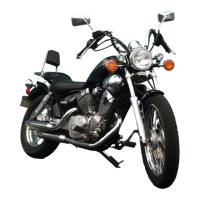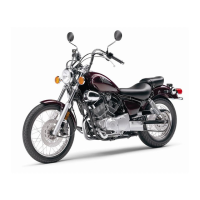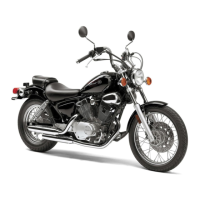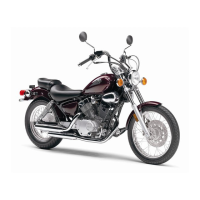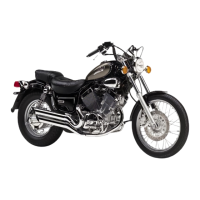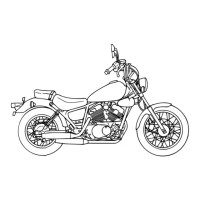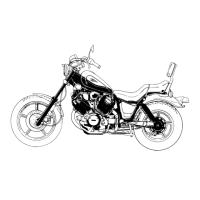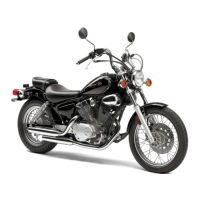
Do you have a question about the Yamaha Virago XV250T 2004 and is the answer not in the manual?
| Engine Type | Air-cooled, 4-stroke, SOHC, V-twin |
|---|---|
| Displacement | 249 cc |
| Bore x Stroke | 49.0 mm x 66.0 mm |
| Compression Ratio | 10.0:1 |
| Ignition | CDI |
| Transmission | 5-speed |
| Final Drive | Chain |
| Front Suspension | Telescopic fork |
| Rear Suspension | Dual shocks |
| Front Brake | Single disc |
| Rear Brake | Drum |
| Front Tire | 3.00-18 |
| Rear Tire | 130/90-15 |
| Fuel System | Carburetor |
| Seat Height | 685 mm (27.0 inches) |
| Fuel Capacity | 9.5 liters |
| Dry Weight | 137 kg (302 lb) |
| Length | 2, 180 mm |
Explains notations and warnings used throughout the manual for rider safety and understanding.
Details the placement and significance of safety labels on the vehicle for user awareness.
Illustrates and identifies components on the left side of the motorcycle.
Illustrates and identifies components on the right side of the motorcycle.
Identifies and describes the location of all controls and instruments on the motorcycle.
Explains main switch positions and the meaning of dashboard indicator lights.
Details controls on handlebars and instrument cluster functions like speedometer.
Describes operation of clutch, brake levers, shift/brake pedals, and fuel tank cap.
Covers starter lever, steering lock, rider seat, helmet holder, and shock absorber adjustment.
Explains sidestand operation and the ignition circuit cut-off system.
Lists essential checks to perform before operating the motorcycle for safety.
Provides steps for starting and warming up the engine from cold or warm.
Explains shifting gears, accelerating, decelerating, and stopping the motorcycle.
Guidelines for engine break-in and proper motorcycle parking procedures.
Locates the tool kit and introduces periodic maintenance charts.
Details periodic maintenance tasks for emission control components.
Outlines general maintenance and lubrication schedules for the vehicle.
Instructions for drive chain, bearings, and chassis fasteners maintenance.
Procedures for engine oil, filter, and brake fluid checks and changes.
Covers checks for spark plugs, air filter, throttle cable, and lubrication.
Guidance on tire pressure, inspection, and wheel maintenance.
Adjustments and checks for brake levers, pedals, and fluid.
Details drive chain lubrication and maintenance for cables and pivots.
Checks for front fork, steering, and wheel bearings condition.
Maintenance for the battery, replacing fuses, and changing bulbs.
Procedures for servicing wheels and a guide for troubleshooting issues.
General guidelines and specific steps for cleaning the motorcycle effectively.
Recommendations for short-term and long-term storage of the motorcycle.
Technical data on the motorcycle's size, weight, engine, and fuel requirements.
Information on frame type, suspension, and brake systems.
Details on electrical system, battery, and lighting components.
Recommended tire pressures and specifications for spoke wheels.
Details on bulb types and fuse ratings for the motorcycle.
How to record key, vehicle, and model identification numbers for reference.
Location and importance of the model label for ordering spare parts.
Procedure for reporting safety defects to NHTSA and Yamaha Motor Corporation.
Information on prohibited tampering with noise control systems.
A chart for documenting scheduled maintenance services for warranty compliance.
Outlines customer duties, maintenance, and warranty transfer procedures.
Details warranty coverage for the motorcycle's emissions control system.
Addresses common warranty queries and provides customer support contact information.
Information on Yamaha's extended service plan for additional coverage.
